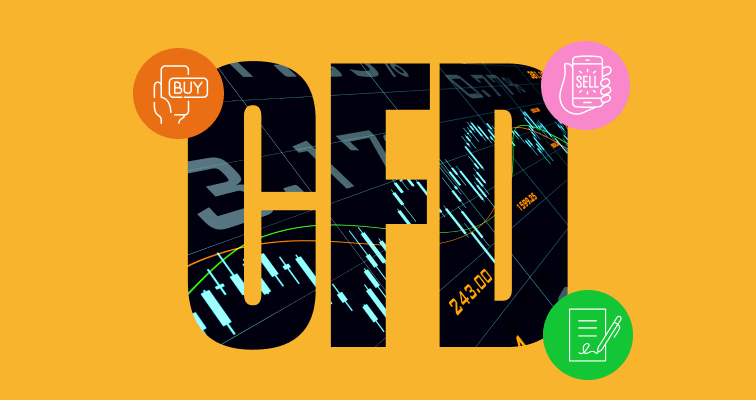What exactly are CFDs, and how does CFD trading work? This easy-to-follow guide will demonstrate how to get the most out of trading CFDs, which can offer opportunities that are not possible with traditional investing.
Using CFDs can allow an individual to trade the price moves of a wide range of financial assets. They can also lead to increased trading functionality, and potentially open the door to a greater number of investment opportunities, but only if you understand how they work and are aware of the risks attached to CFD trading.
What is a CFD?
The term “Contract for Difference” (CFD) refers to an agreement between a trader and their broker. The “contract” sets out that one of the two parties will pay the other, depending on which direction the price of an asset moves. The amount of the cash settlement is calculated using the “difference” between the price at the open and close of the trade.
CFD trading is a method of trading the value of an underlying asset, rather than the asset itself. The “derivative” nature of CFDs makes them highly versatile and has resulted in the market, first developed in the 1990s, growing to be worth billions of dollars.

Why trade CFDs?
Not owning the underlying asset can enable traders to utilise some interesting functionality features.
CFD Market Coverage
CFDs can be used to trade a wide range of asset groups, such as stocks, indices, forex and commodities. This can open up new markets to investors looking to trade different asset groups in a user-friendly and potentially less capital intensive way. Whichever market you are targeting, the process of booking a trade will be the same.
Short selling CFDs
CFD trading allows you to “sell” a market if you think it is overvalued. “Short selling” allows investors to take advantage of downwards price moves, rather than being forced to follow a traditional “buy-and-hold” approach. Stop-losses can be implemented when opening short positions to help manage risk and mitigate losses.
Leveraged trading with CFDs
Leverage allows you to decrease the size of your deposit and use your capital more effectively. Leverage trading involves using the cash in your brokerage account as a deposit, known as margin, so that you only put up a percentage of the cost of buying a position. When trading with leverage, potential profits or losses will be calculated according to the full size of your position, not just the margin.
Let’s use a real-world example. Oil is a commodity that is available to be traded as a CFD. If you invested $100 into a position with 10x leverage, the total size of your position would be $1,000. If the price of oil rose by 5%, your position would be worth $1,050, demonstrating a profit of $50. If the price fell by 5%, your position would be worth $950 — a loss of $50. If you completed the same trade without leverage, your profit or loss would be $5, depending on which direction the price moved. Leverage magnifies both your profits and losses, and so should be used carefully.
| Margin | Leverage | Position Size | Price Change | New Position Size | Funds After Price Change |
|---|---|---|---|---|---|
| $100 | 1:1 | $100 | +5% | $105 | $105 |
| -5% | $95 | $95 | |||
| $100 | 1:10 | $1,000 | +5% | $1,050 | $150 |
| -5% | $950 | $50 |
The functionality of CFDs does need to be considered in terms of risk management. Most of the features listed above can make the returns on a losing trade worse, so should only be used by investors who have conducted thorough research and have appropriately incorporated risk into their investment plan.
Novice Traders trade 5 to 10 times too big. They are taking 5 to 10 percent risk on a trade they should be taking 1 to 2 percent risk on.
Bruce Kovner

How do you trade a CFD?
Traditional investing usually involves following a simple strategy: “buy low, sell high.” CFD trading follows that same pattern, but investors can also use an alternative method to try and profit from market moves: “sell high, buy low.”
If you buy a CFD in Apple Inc stock and the price rises, your broker will credit your account in line with the price move, once you have closed the position. If the price falls, you’ll record a loss, and your broker will debit your account the appropriate amount of cash. When you sell short, rather than go long on a CFD position, you will profit if the price of the underlying asset falls.
Regardless of the asset type that you are trading, the principle of how profit and loss is calculated on a CFD trade is the same. Whether your CFD is in gold, GBPUSD or the NASDAQ 100 Index, you won’t own the underlying asset, but are instead speculating on how the asset’s price will move.
Trading using leverage can incur overnight financing fees. These might not be large but still need to be factored into your strategy planning. In fact, these fees are one of the main reasons that CFDs are primarily used for short-term trading. If investing in CFDs over a longer period of time, the fees incurred could negate any potential profits or exacerbate any losses.

Final thoughts
The additional functionality offered by CFDs will not help you to make more accurate calls regarding the direction of the market. However, CFDs do allow you the opportunity to profit from both downwards and upwards price moves and you can use leverage to lower your margin. Remember, there are risks attached to CFD trading, and so you should never invest more than you can afford to lose.
Visit the eToro Academy to learn how to get the most out of CFD trading.
FAQs
- How long can I hold a CFD?
-
CFDs don’t have an expiry date so they can be held indefinitely, regardless of whether you have opened a long or short position. However, there are spreads and overnight fees attached to CFD trades, so holding a CFD for long periods can incur significant additional costs.
- Is CFD trading safe?
-
CFD trading is safe, but there are several risks involved of which both new and experienced investors should be aware. The FCA (Financial Conduct Authority) classifies CFDs as “high-risk products.” Trading using leverage increases the potential size of both profits and losses, while short selling theoretically leaves traders exposed to infinite losses, as the price can always continue rising. If your equity level falls below the required minimum, your broker can automatically close your positions and you will lose all of your initial investment.
- Is CFD trading legal?
-
CFD trading is legal in many countries. In many countries, CFDs are the primary method of trading short-term price movements. However, there are certain characteristics associated with CFDs that mean they are not permitted in certain territories.
- What are underlying assets?
-
When trading CFDs, an investor does not actually own the asset itself. Instead, investors can trade derivative instruments such as CFDs, which track the price of the actual asset (known as the “underlying asset”). Underlying assets could include stocks and commodities, among others.
This information is for educational purposes only and should not be taken as investment advice, personal recommendation, or an offer of, or solicitation to, buy or sell any financial instruments.
This material has been prepared without regard to any particular investment objectives or financial situation and has not been prepared in accordance with the legal and regulatory requirements to promote independent research. Not all of the financial instruments and services referred to are offered by eToro and any references to past performance of a financial instrument, index, or a packaged investment product are not, and should not be taken as, a reliable indicator of future results.
eToro makes no representation and assumes no liability as to the accuracy or completeness of the content of this guide. Make sure you understand the risks involved in trading before committing any capital. Never risk more than you are prepared to lose.


